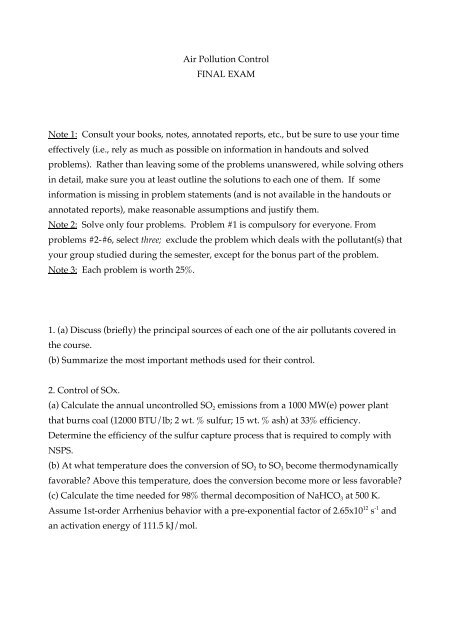Air Pollution Control FINAL EXAM Note 1: Consult your books, notes ...
Air Pollution Control FINAL EXAM Note 1: Consult your books, notes ...
Air Pollution Control FINAL EXAM Note 1: Consult your books, notes ...
Create successful ePaper yourself
Turn your PDF publications into a flip-book with our unique Google optimized e-Paper software.
<strong>Air</strong> <strong>Pollution</strong> <strong>Control</strong><br />
<strong>FINAL</strong> <strong>EXAM</strong><br />
<strong>Note</strong> 1: <strong>Consult</strong> <strong>your</strong> <strong>books</strong>, <strong>notes</strong>, annotated reports, etc., but be sure to use <strong>your</strong> time<br />
effectively (i.e., rely as much as possible on information in handouts and solved<br />
problems). Rather than leaving some of the problems unanswered, while solving others<br />
in detail, make sure you at least outline the solutions to each one of them. If some<br />
information is missing in problem statements (and is not available in the handouts or<br />
annotated reports), make reasonable assumptions and justify them.<br />
<strong>Note</strong> 2: Solve only four problems. Problem #1 is compulsory for everyone. From<br />
problems #2-#6, select three; exclude the problem which deals with the pollutant(s) that<br />
<strong>your</strong> group studied during the semester, except for the bonus part of the problem.<br />
<strong>Note</strong> 3: Each problem is worth 25%.<br />
1. (a) Discuss (briefly) the principal sources of each one of the air pollutants covered in<br />
the course.<br />
(b) Summarize the most important methods used for their control.<br />
2. <strong>Control</strong> of SOx.<br />
(a) Calculate the annual uncontrolled SO 2 emissions from a 1000 MW(e) power plant<br />
that burns coal (12000 BTU/lb; 2 wt. % sulfur; 15 wt. % ash) at 33% efficiency.<br />
Determine the efficiency of the sulfur capture process that is required to comply with<br />
NSPS.<br />
(b) At what temperature does the conversion of SO 2 to SO 3 become thermodynamically<br />
favorable? Above this temperature, does the conversion become more or less favorable?<br />
(c) Calculate the time needed for 98% thermal decomposition of NaHCO 3 at 500 K.<br />
Assume 1st-order Arrhenius behavior with a pre-exponential factor of 2.65x10 12 s -1 and<br />
an activation energy of 111.5 kJ/mol.
3. <strong>Control</strong> of NOx.<br />
(a) Estimate the uncontrolled emissions of nitrogen oxides from the same plant as in #2,<br />
using a typical emission factor rating. Does this plant need to install NOx control<br />
equipment to meet the NSPS?<br />
(b) Aviation kerosene (CH 1.88 ) is burned at 2250 K and 10 atm, with a residence time of 5<br />
milliseconds. If the equivalence ratio is 1.0, calculate the mole fraction of NO in the<br />
gaseous product. Compare <strong>your</strong> result with the solutions to E6.2 and P6.3 in Ben’tez<br />
(op. cit.) and comment on the trends observed.<br />
4. <strong>Control</strong> of COx.<br />
(a) Estimate the uncontrolled emissions of carbon oxides (both CO and CO 2 ) from the<br />
same plant as in #2, using a typical emission factor rating for CO.<br />
(b) When 50% of blood hemoglobin is converted to HbCO, a person is very close to<br />
death. If a person breathes 4 liters of air per minute and air contains ten times more CO<br />
than permitted by 1-h NAAQS, how much time is needed to reach this HbCO level?<br />
Use the assumptions in P1.7, Ben’tez (op. cit.).<br />
(c) Australia's 1990 emissions of CO 2 (equiv.) were 385 million tons. If one of the<br />
projections for the year 2010, 540 million tons, is indeed realized, by how much will<br />
Australia need to reduce these emissions to meet the requirements of the Kyoto<br />
Protocol?<br />
5. <strong>Control</strong> of PM.<br />
(a) Estimate the uncontrolled emissions of particulate matter from the same plant as in<br />
#2, using a typical emission factor rating. Does this plant need to install PM control<br />
equipment to meet the NSPS?<br />
(b) A group of particles is described by the log-normal distribution with a mass-mean<br />
diameter of 10 µm and a standard deviation of 1.5. Calculate the mass fraction of the<br />
particles having diameter less than 1 µm. An air stream containing these particles goes<br />
through a collector that is 100% efficient for particles with D ³ 40µm, 50% efficient for<br />
particles 10-40 µm and 10% efficient for particles smaller than 10 µm. Calculate the<br />
mass fraction of particles removed by this collector.
6. <strong>Control</strong> of VOCs.<br />
(a) Explain in as much detail as possible, and with relevant quantitative examples,<br />
Figure D.1 in de Nevers (op. cit.) which shows how ozone concentration in polluted air<br />
varies with changes in NOx and VOC concentrations.<br />
(b) The gaseous effluent from a chemical process (20 m 3 /s; 300 K, 1 atm) contains 3000<br />
ppm toluene, 20% O 2 and 79.7% N 2 . Calculate the temperature needed to reduce toluene<br />
concentration to 20 ppm in a thermal incinerator with a residence time of 0.6 seconds.<br />
(c) Toluene concentration in the vicinity of the plant was reported to be ~1 µg/m 3 . Show<br />
whether this is within the range given in Figure D.1.
















